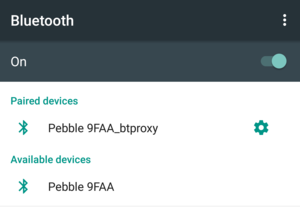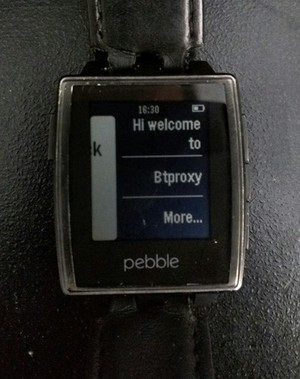Proxying Bluetooth devices for security analysis using btproxy
05 September 2015btproxy
I’ve recently been interested in investigating the security of new technologies. New devices, especially in the “IoT” realm, use Bluetooth to communicate. I got interested finding a good way to get insight to Bluetooth connections. I wanted to be able to see traffic in clear text and modify it actively, similar to many existing tools for internet traffic. However, there isn’t really any cheap and easy methods for doing so.
I wrote a tool that will leverage 1 or 2 regular Bluetooth adapters to act as a proxy for two other devices connecting to each other. Proxying the connection allows insight into clear text traffic and the ability to modify it in real time.
Installation
The code currently lives on Github and currently only works on Linux or OS X. It relies on BlueZ.
Install the dependencies:
sudo apt-get install bluez bluez-utils bluez-tools libbluetooth-dev python-dev
Install btproxy:
git clone https://github.com/conorpp/btproxy
cd btproxy
sudo python setup.py install
Running it on the Pebble Watch
To run it, you will need two Bluetooth devices to proxy (Bluetooth low energy doesn’t work yet).
I choose to use my Phone (Nexus 6) and Pebble Steel watch.
So I went ahead and made each device Bluetooth discoverable. For the Nexus 6 running Android L, this just means opening Bluetooth in the settings. For the Pebble watch, you just open Bluetooth in the settings as well.
Now that they are visible, the Proxy can run.
I use hcitool to scan for the devices so I know their Bluetooth MAC addresses.
$ hcitool scan
Scanning ...
77:88:99:AA:BB:CC Pebble 9FAA
11:22:33:44:55:66 conorpp's Nexus 6
Now to run the Bluetooth proxy.
sudo btproxy 11:22:33:44:55:66 77:88:99:AA:BB:CC
Notice I put the phone’s MAC address first. This is important because the phone is the master device in the connection and the watch is the slave. This master/slave setup is part of the Bluetooth protocol. Slave devices are typically the ones to sit and advertise until a master device requests for a connection. A master can connect to multiple devices while a slave can only have one connection.
 credit: sparkfun.com
credit: sparkfun.com
Now let’s follow the output of the proxy.
$ sudo btproxy 11:22:33:44:55:66 77:88:99:AA:BB:CC
Running proxy on master 11:22:33:44:55:66 and slave 77:88:99:AA:BB:CC
Using shared adapter
Slave adapter: hci0
Master adapter: hci0
Looking up info on slave (77:88:99:AA:BB:CC)
Looking up info on master (11:22:33:44:55:66)
Spoofing master name as Pebble 9FAA_btproxy
Running inquiry scan
paired
Spoofing master name as Pebble 9FAA_btproxy
Proxy listening for connections for "Serial Port Server Port 1"
Proxy listening for connections for "Audio/Video Remote Control"
Attempting connections with 2 services on slave
Connected to service "Audio/Video Remote Control"
Connected to service "Serial Port Server Port 1"
Now you're free to connect to "Pebble 9FAA_btproxy" from master device.
The Proxy will look up the name and class of the devices about to be proxied so it can copy the name and class to the Bluetooth adapters being used. In this case only one adapter is being used so it will only copy the slave’s properties.
Halfway through this it makes a pairing request to my Pebble watch, to which I accept. The proxy then opens Bluetooth sockets for each service that the watch device hosts, which will be what the phone connects to. The proxy connects to the services on the watch. Once this is done, I connect the master device (my phone) to the proxy device (Pebble 9FAA_btproxy).


btproxy output:
Accepted connection from ('11:22:33:44:55:66', 1)
>> b'\x00\x1e\x001\x01\x1b\x07\xe0\xd9\xcb\x89WK\xf7\x9dB5\xbfG\xca\xad\xfe\x01\x01\x00\x00\x00\x02\x04\x00\x01\x00\x00\x00\x00\x01\x00\x11\x00'
<< b'\x00\x11\x00\x11\x01\xff\xff\xff\xff\x00\x00\x00\x00\x00\x00\x00\x02\x02\x02\x04\x00'
<< b'\x00\x01\x00\x10\x00'
>> b'\x00\x96\x00\x10\x01U\t\xb4\xfbv2.9.1\x00\x00\x00\x00\x00\x00\x00\x00\x00\x00\x00\x00\x00\x00\x00\x00\x00\x00\x00\x00\x00\x00\x00\x00\x00\x0054664bd\x00\x00\x06\x01R"T_v1.5.5\x00\x00\x00\x00\x00\x00\x00\x00\x00\x00\x00\x00\x00\x00\x00\x00\x00\x00\x00\x00\x00\x00\x00\x00\x00\x001c16275\x00\x01\x06\x01R\xe2\xf82102V1\x00\x00\x00\x00Q206134E01L3\xaa\x9f\xa6\xe9\x17\x00&e\x8a\x03U\t\xb4\xfben_US\x00\x00\x01XXXXXXX\x00'
<< b'\x00\x0b\x13\x89\x00\tmfg_color'
>> b'\x00\x06\x13\x89\x01\x04\x00\x00\x00\x07'
<< b'\x00\x01\x17p\x01'
>> b'\x00\t\x17p\x01\x00\x00\x00\x08\x00\x00\x00\x00'
<< b'\x00\x05\x00\x0b\x02U\xec^4'
There are two protocols getting dumped here: SPP and Pebble. They are binary protocols which is why it’s unreadable. But sending a notification should come up as clear text. Here is what gets logged after I sent myself a text message:
<< b'\x00F\x0b\xc2\x00\x01\x00\x00\x00\x00\x00\x00\x00\x00\x00\x00\x00\x00K_\xecU\x01\x02\x03\x01\x0e\x00(123) 456-6789\x03\x0c\x00Hello Pebble\xff\x05\x00\xfe\x05\x00\x01\x03\x01\x01\x05\x00Reply'
You can see the phone number and the contents of the text message, “Hello Pebble”.
Here’s the packet sent after I sent myself a Google Hangouts message:
<< b'\x00b\x0b\xc2\x00\x01\x00\x00\x00\x00\x01\x00\x00\x00\x00\x00\x00\x00\xf2_\xecU\x01\x02\x02\x01\r\x00Conor Patrick\x03\x1a\x00Sent a message on Hangouts\x01\x02\x01\x01\r\x00Open on phone\x02\x04\x01\x01\x07\x00Dismiss'
You can see it sent two options: “Open on phone” and “Dismiss”.
Anything in the packets can be altered in real time using an inline Python script.
For example:
# replace.py
# This replaces the options in a Pebble notification packet
def master_cb(req):
req = req.replace(b'Open on phone', b'Hi welcome to')
req = req.replace(b'Dismiss', b'Btproxy')
print( '<< ', repr(req))
return req
def slave_cb(res):
print('>> ', repr(res))
return res
master_cb is called when the master device (phone) is sending a packet to the slave (watch). And vice versa with slave_cb.
Restart btproxy:
sudo btproxy 11:22:33:44:55:66 77:88:99:AA:BB:CC -s replace.py
Then send a notification:

Concluding Thoughts
I’ve intended this tool to be used for analysis, and can be used for getting security insights for the increasing amount of “IoT” devices out there.
So far I’ve used it to pull apps, firmware updates, certificates/credentials, and change identifiers.
It’s not ideal for an actual attack, unless there was some clever way for forcing already paired devices to unpair and then
hope they reconnect to the proxy. Forcing unpairing has been done using an Ubertooth but it’s not something that I have
looked into yet.
